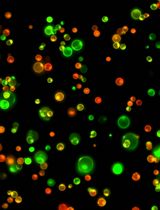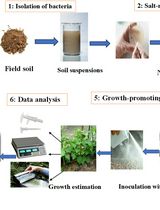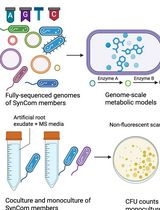- EN - English
- CN - 中文
Extraction and 16S rRNA Sequence Analysis of Microbiomes Associated with Rice Roots
水稻根系相关微生物群落的分离及其16S rRNA序列分析
(*contributed equally to this work) 发布: 2018年06月20日第8卷第12期 DOI: 10.21769/BioProtoc.2884 浏览次数: 18553
评审: Joëlle SchlapferYang BaiFrancesco Dal Grande
Abstract
Plant roots associate with a wide diversity of bacteria and archaea across the root-soil spectrum. The rhizosphere microbiota, the communities of microbes in the soil adjacent to the root, can contain up to 10 billion bacterial cells per gram of soil (Raynaud and Nunan, 2014) and can play important roles for the fitness of the host plant. Subsets of the rhizospheric microbiota can colonize the root surface (rhizoplane) and the root interior (endosphere), forming an intimate relationship with the host plant. Compositional analysis of these communities is important to develop tools in order to manipulate root-associated microbiota for increased crop productivity. Due to the reduced cost and increasing throughput of next-generation sequencing, major advances in deciphering these communities have recently been achieved, mainly through the use of amplicon sequencing of the 16S rRNA gene. Here we first present a protocol for dissecting the microbiota from various root compartments, developed using rice as a model. We next present a method for amplifying fragments of the 16S rRNA gene using a dual index approach. Finally, we present a simple workflow for analyzing the resulting sequencing data to make ecological inferences.
Keywords: Root microbiome (根系微生物群落)Background
Various plant root niches host different microbial communities (microbiota) originating from the soil (Bulgarelli et al., 2012; Lundberg et al., 2012; Edwards et al., 2015; Zarraonaindia et al., 2015; Wagner et al., 2016). Distinct microbiota acquired by each root niche likely have varying metabolic potential and may therefore impact the health of the host plant in different ways (Finkel et al., 2017). Bacterial and archaeal community composition in root-associated microbiota can be inferred through the use of 16S rRNA gene sequencing (Caporaso et al., 2012). The relatively low cost of sequencing now allows for comparative studies across plant species using datasets gathered by different research groups; however, small aberrations in specimen collection, sequencing, and analysis protocols may lead to large differences in the inferred microbial communities (Duvallet et al., 2017). We present this protocol detailing how to collect and analyze root microbiota from rice in an attempt to promote reproducibility across the plant microbiome field.
Materials and Reagents
- Falcon 50 ml conical centrifuge tubes (Corning, Falcon®, catalog number: 352070 )
- 1.5 ml microfuge tubes (E&K Scientific Products, catalog number: 280150 )
- 1.5 ml non-stick microfuge tubes (Thermo Fisher Scientific, AmbionTM, catalog number: AM12450 )
- 0.2 ml PCR tubes (GeneMate, catalog number: 3235-00-210IS )
- Filtered pipette tips (10, 200, 1,000 µl) (VWR, catalog numbers: 89168-750, 89140-936, 89168-754)
Manufacturer: Biotix, catalog number: BT10XLS3 , BT200 , BT1250 . - Gloves (Medline Industries, catalog numbers: large, MDS192086 ; medium, MDS192085 ; small, MDS192084 )
- Qubit 0.5 ml assay tubes (Thermo Fisher Scientific, catalog number: Q32856 )
- Single edge razor blade (Personna, catalog number: 94-115-71 )
- Nuclease-free water (Thermo Fisher Scientific, AmbionTM, catalog number: AM9939 )
- DNeasy PowerSoil kit (QIAGEN, catalog number: 12888-100 )
- Primer 515F (GTGCCAGCMGCCGCGGTAA)
- Primer 806R (GGACTACHVGGGTWTCTAAT)
- HotStar High Fidelity DNA polymerase kit (QIAGEN, catalog number: 202602 )
- Agencourt Ampure XP beads (Beckman Coulter, catalog number: A63880 )
- Qubit dsDNA HS assay kit (Thermo Fisher Scientific, catalog number: Q32851 )
- Ethanol 200 proof (Sigma-Aldrich, catalog number: E7023-500ML )
- Agarose (Biotech Sources, catalog number: G01PD-500 )
- DNA gel loading dye
- NucleoSpin gel and PCR clean-up kit (MACHEREY-NAGEL, catalog number: 740609.250 )
- NaCl (Fisher Scientific, catalog number: S271-1 )
- KCl (Fisher Scientific, catalog number: P217-500 )
- Na2HPO4 (Fisher Scientific, catalog number: S374-500 )
- KH2PO4 (Fisher Scientific, catalog number: P285-500 )
- Autoclaved phosphate buffered saline (PBS) solution (~100 ml/plant) (see Recipes)
Equipment
- 96 well magnetic plate (Alpaqua Engineering, catalog number: A001219R )
- 1.5 ml tube magnetic rack (Thermo Fisher Scientific, catalog number: MR01 )
- Pipettes (2.5, 10, 200, 1,000 µl) (Thermo Fisher Scientific, FinnpipetteTM, catalog numbers: 4641010N , 4641030N , 4641080N , 4641100N )
- Ultrasonic cleaning bath, 40 kHz (Branson, model: Branson 1800, catalog number: CPX-952-116R )
- Dissection tools (scissors and forceps) (scissors: Bioseal, catalog number: KI011/50 ; forceps: Integra LifeSciences, Miltex, catalog number: 6-184 )
- -80 °C freezer
- Microcentrifuge (Eppendorf, model: 5417C )
- Mini-Beadbeater-96 high-throughput cell disrupter (Bio Spec Products, catalog number: 1001 )
- Electrophoresis gel unit (Bio-Rad Laboratories, catalog number: 1704468 )
- Qubit fluorometer (Thermo Fisher Scientific, catalog number: Q33226 )
- PCR thermal cycler (Bio-Rad Laboratories, model: T100TM Thermal Cycler , catalog number: 1861096)
Software
- Python2 version 2.7.12
- R version 3.4.3
Procedure
文章信息
版权信息
© 2018 The Authors; exclusive licensee Bio-protocol LLC.
如何引用
Edwards, J., Santos-Medellín, C. and Sundaresan, V. (2018). Extraction and 16S rRNA Sequence Analysis of Microbiomes Associated with Rice Roots. Bio-protocol 8(12): e2884. DOI: 10.21769/BioProtoc.2884.
分类
植物科学 > 植物免疫 > 宿主-细菌相互作用
微生物学 > 群落分析 > 宏基因组学
系统生物学 > 基因组学 > 测序
您对这篇实验方法有问题吗?
在此处发布您的问题,我们将邀请本文作者来回答。同时,我们会将您的问题发布到Bio-protocol Exchange,以便寻求社区成员的帮助。
提问指南
+ 问题描述
写下详细的问题描述,包括所有有助于他人回答您问题的信息(例如实验过程、条件和相关图像等)。
Share
Bluesky
X
Copy link












